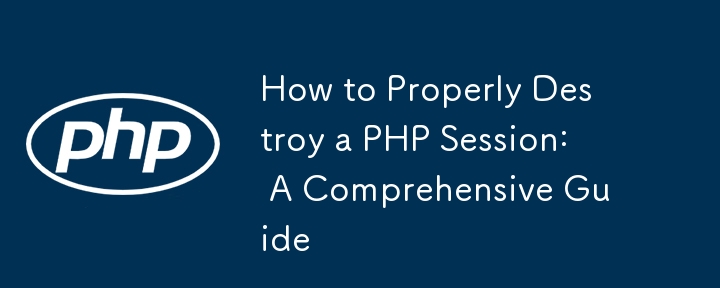

Destroying PHP Sessions: A Comprehensive Approach
When terminating a PHP session, it is essential to ensure that all relevant data is deleted and the session ID is invalidated. While various methods have been suggested, the most effective approach involves a multi-step process:
Deleting Session Data:
<code class="php">session_start(); $_SESSION = array();</code>
This wipes out any session data that may still be present.
Invalidating Session ID:
<code class="php">session_destroy();</code>
This destroys the current session ID and generates a new one.
Preventing Session Continuity:
<code class="php">unset($_COOKIE[session_name()]);</code>
This forces the browser to discard the session cookie, preventing it from attaching to a new session.
To ensure that only authorized sessions are established, it is recommended to create a unique session flag upon session initialization and check for its presence:
<code class="php">session_start();
if (!isset($_SESSION['CREATED'])) {
session_regenerate_id(true);
$_SESSION['CREATED'] = time();
}</code>Finally, to limit the lifetime of the session ID, the following code can be used to periodically swap it:
<code class="php">if (time() - $_SESSION['CREATED'] > ini_get('session.gc_maxlifetime')) {
session_regenerate_id(true);
$_SESSION['CREATED'] = time();
}</code>By following these steps, you can effectively destroy a PHP session and ensure that it cannot be resumed without authorization.
The above is the detailed content of How to Properly Destroy a PHP Session: A Comprehensive Guide. For more information, please follow other related articles on the PHP Chinese website!
 The difference between gateway and router
The difference between gateway and router
 How to recover files emptied from Recycle Bin
How to recover files emptied from Recycle Bin
 How to fix libcurl.dll missing from your computer
How to fix libcurl.dll missing from your computer
 Delete exif information
Delete exif information
 WiFi shows no access to the Internet
WiFi shows no access to the Internet
 My computer can't open it by double-clicking it.
My computer can't open it by double-clicking it.
 How to restore friends after being blocked on TikTok
How to restore friends after being blocked on TikTok
 Introduction to javascript special effects code
Introduction to javascript special effects code




